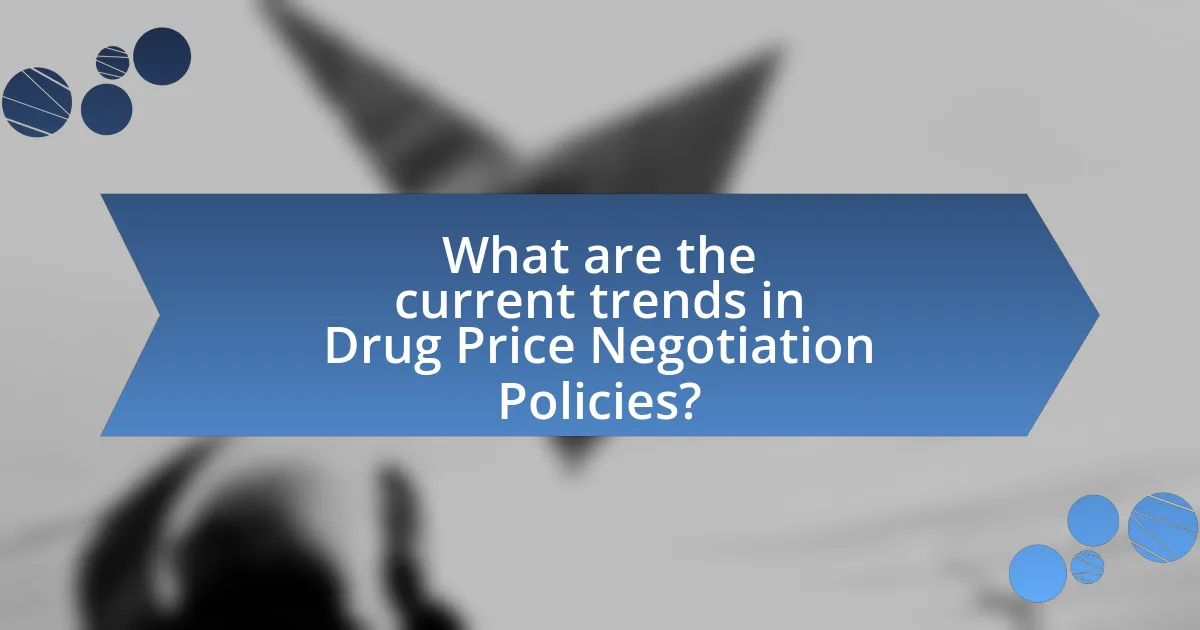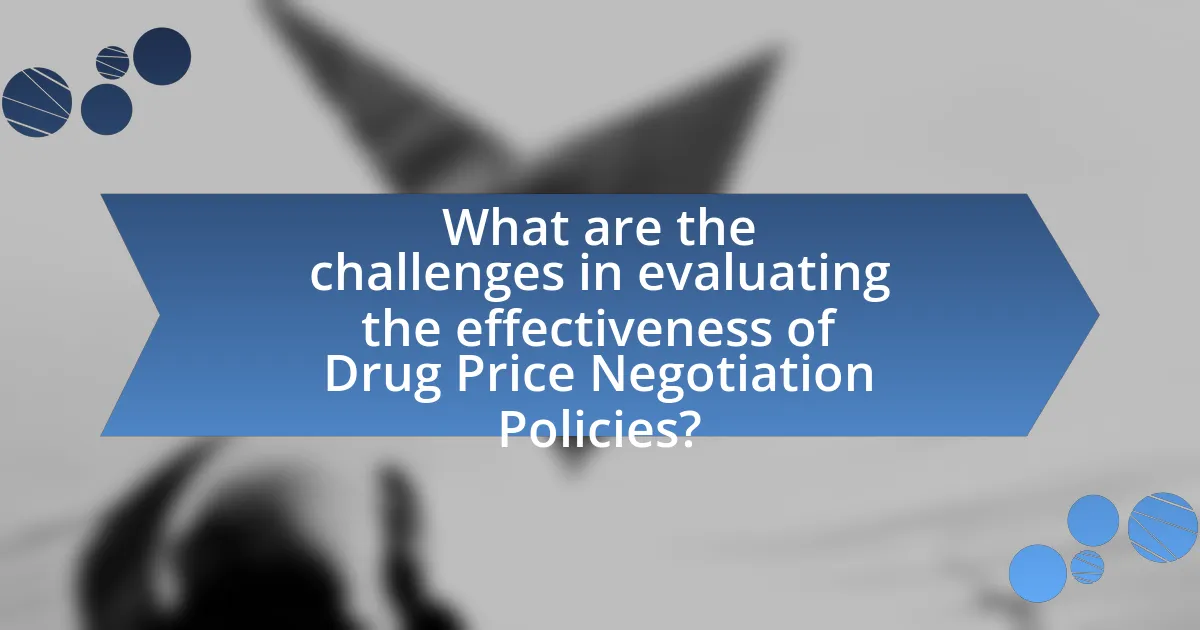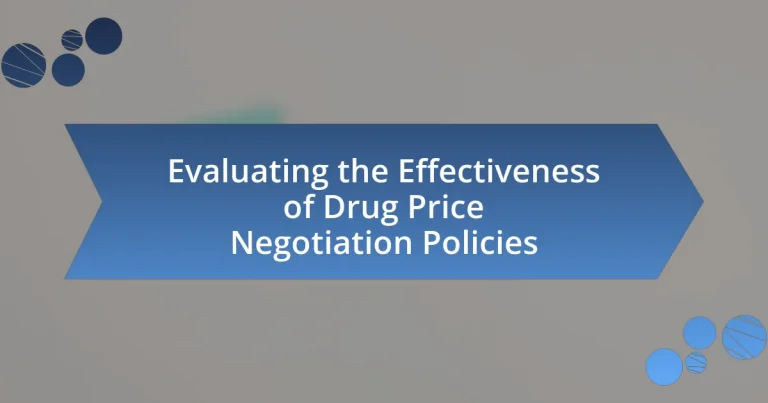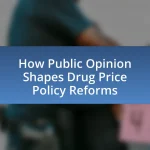Drug Price Negotiation Policies are regulations that enable government entities and health organizations to negotiate pharmaceutical prices directly with manufacturers, aiming to reduce costs for consumers and healthcare systems. This article evaluates the effectiveness of these policies by examining their functions, key components, and the impact on healthcare costs and patient access to medications. It discusses current trends, recent legislative changes, and the roles of various stakeholders in the negotiation process. Additionally, the article highlights challenges in evaluating these policies, metrics for assessment, and case studies that illustrate their effectiveness, ultimately identifying best practices for enhancing negotiation outcomes.

What are Drug Price Negotiation Policies?
Drug Price Negotiation Policies are regulations that allow government entities or health organizations to negotiate the prices of pharmaceuticals directly with manufacturers. These policies aim to reduce drug costs for consumers and healthcare systems by leveraging the purchasing power of public programs, such as Medicare in the United States, to secure lower prices. Evidence from countries with similar policies, like Canada and many European nations, shows that negotiated prices can lead to significant savings on essential medications, thereby improving access to healthcare.
How do Drug Price Negotiation Policies function?
Drug price negotiation policies function by allowing government entities or designated organizations to negotiate prices directly with pharmaceutical companies for specific medications. These policies aim to lower drug costs for consumers and healthcare systems by leveraging the purchasing power of the government or large health plans to secure better pricing terms. For instance, the Inflation Reduction Act of 2022 enables Medicare to negotiate prices for certain high-cost drugs, which is expected to reduce expenditures significantly. This approach is supported by evidence indicating that negotiated prices can lead to substantial savings, as seen in countries with established price negotiation frameworks, where drug prices are often lower than in the United States.
What are the key components of Drug Price Negotiation Policies?
The key components of Drug Price Negotiation Policies include the establishment of a framework for negotiating prices between government entities and pharmaceutical companies, transparency in pricing and cost structures, and the inclusion of criteria for determining fair pricing based on market value and therapeutic benefit. These components aim to ensure that negotiated prices reflect the true value of medications while promoting accessibility for patients. Evidence from countries with successful negotiation policies, such as Canada and Australia, demonstrates that structured negotiation processes can lead to significant cost savings and improved access to essential medications.
How do these components influence drug pricing?
Drug pricing is influenced by various components, including production costs, market competition, regulatory frameworks, and negotiation policies. Production costs, which encompass research and development, manufacturing, and distribution expenses, directly affect the final price set by pharmaceutical companies. Market competition can drive prices down, as multiple companies may offer similar drugs, leading to price wars. Regulatory frameworks, such as patent laws and approval processes, can either protect drug prices by limiting competition or facilitate lower prices through generics. Negotiation policies, particularly those implemented by governments or insurance companies, can significantly lower prices by leveraging bulk purchasing power and setting price ceilings. For instance, countries with established price negotiation policies often report lower drug prices compared to those without such frameworks, demonstrating the impact of these components on overall pricing strategies.
Why are Drug Price Negotiation Policies important?
Drug price negotiation policies are important because they aim to reduce the cost of medications for consumers and healthcare systems. By allowing government entities or insurers to negotiate prices directly with pharmaceutical companies, these policies can lead to lower drug prices, increased access to essential medications, and overall savings in healthcare expenditures. For instance, studies have shown that countries with drug price negotiation mechanisms, such as Canada, often pay significantly less for prescription drugs compared to the United States, where such negotiations are limited. This demonstrates that effective negotiation policies can lead to substantial financial relief for patients and the healthcare system as a whole.
What impact do these policies have on healthcare costs?
Drug price negotiation policies significantly reduce healthcare costs. By allowing government entities to negotiate prices directly with pharmaceutical companies, these policies can lead to lower drug prices, which in turn decreases overall healthcare expenditures. For instance, a study by the Congressional Budget Office estimated that implementing such negotiation policies could save the federal government approximately $100 billion over ten years. Additionally, lower drug prices can alleviate financial burdens on patients, leading to increased access to necessary medications and potentially reducing hospitalizations and other healthcare services associated with untreated conditions.
How do they affect patient access to medications?
Drug price negotiation policies significantly enhance patient access to medications by lowering the costs of prescription drugs. These policies enable governments or organizations to negotiate prices directly with pharmaceutical companies, resulting in reduced out-of-pocket expenses for patients. For instance, a study by the Congressional Budget Office indicated that implementing such negotiation strategies could lead to savings of approximately $100 billion over ten years, thereby making essential medications more affordable for a larger segment of the population. Consequently, improved affordability directly correlates with increased access to necessary treatments, particularly for low-income individuals who may otherwise forgo medications due to high costs.

What are the current trends in Drug Price Negotiation Policies?
Current trends in drug price negotiation policies include increased government involvement, transparency in pricing, and the implementation of value-based pricing models. Governments, particularly in the United States with the Inflation Reduction Act, are now empowered to negotiate prices for certain high-cost medications, aiming to lower expenses for consumers and the healthcare system. Transparency initiatives require pharmaceutical companies to disclose pricing structures and justifications, fostering accountability. Additionally, value-based pricing models are gaining traction, where drug prices are linked to the clinical outcomes they deliver, ensuring that costs reflect the actual benefits provided to patients. These trends are supported by data indicating that negotiated prices can lead to significant savings; for example, studies have shown that price negotiations can reduce costs by up to 30% for certain medications.
How have recent legislative changes influenced these policies?
Recent legislative changes have significantly influenced drug price negotiation policies by enabling the government to negotiate prices directly with pharmaceutical companies. The Inflation Reduction Act of 2022, for instance, allows Medicare to negotiate prices for certain high-cost drugs, which is expected to lower costs for consumers and increase access to medications. This legislative shift marks a departure from previous policies that restricted such negotiations, aiming to reduce overall healthcare spending and improve affordability for patients.
What specific laws have been enacted regarding drug price negotiations?
The Inflation Reduction Act of 2022 is a specific law enacted regarding drug price negotiations. This legislation allows the federal government to negotiate prices for certain high-cost prescription drugs covered under Medicare, aiming to lower costs for beneficiaries. The law mandates that the Department of Health and Human Services select a limited number of drugs for negotiation each year, with the first negotiations set to begin in 2026. This act represents a significant shift in U.S. healthcare policy, as it is the first time the government has been granted the authority to negotiate drug prices directly, which is expected to impact the overall pricing landscape in the pharmaceutical market.
How have these laws changed the negotiation landscape?
The implementation of drug price negotiation laws has significantly altered the negotiation landscape by empowering government entities to directly negotiate prices with pharmaceutical companies. This shift has led to increased transparency in pricing and has pressured drug manufacturers to justify their pricing strategies. For instance, the Inflation Reduction Act of 2022 allows Medicare to negotiate prices for certain high-cost drugs, which is projected to save taxpayers billions and reduce out-of-pocket costs for patients. Additionally, studies indicate that such laws can lead to lower drug prices, as seen in countries with established price negotiation frameworks, where drug costs are often significantly lower than in the United States.
What role do stakeholders play in Drug Price Negotiation Policies?
Stakeholders play a critical role in drug price negotiation policies by influencing the negotiation process, shaping policy outcomes, and ensuring that various interests are represented. Key stakeholders include government agencies, pharmaceutical companies, healthcare providers, and patient advocacy groups, each contributing unique perspectives and priorities. For instance, government agencies aim to balance cost containment with access to medications, while pharmaceutical companies seek to protect their profit margins. Research indicates that effective stakeholder engagement can lead to more equitable and sustainable drug pricing solutions, as seen in countries like Canada, where collaborative approaches have resulted in lower drug prices without compromising innovation.
Who are the key stakeholders involved in drug price negotiations?
The key stakeholders involved in drug price negotiations include pharmaceutical companies, government agencies, healthcare providers, insurers, and patient advocacy groups. Pharmaceutical companies set the initial prices for drugs and negotiate with other stakeholders to determine final costs. Government agencies, such as the Centers for Medicare & Medicaid Services in the U.S., play a crucial role in regulating prices and ensuring access to medications. Healthcare providers, including doctors and hospitals, influence negotiations by advocating for fair pricing based on patient needs. Insurers negotiate with pharmaceutical companies to manage costs and coverage for their members. Lastly, patient advocacy groups represent the interests of patients, pushing for affordable access to necessary medications. These stakeholders collectively shape the landscape of drug pricing through their negotiations and interactions.
How do the interests of these stakeholders align or conflict?
The interests of stakeholders in drug price negotiation policies often conflict due to differing priorities. Pharmaceutical companies prioritize profit maximization and market exclusivity, while government entities and consumers seek lower drug prices and increased access to medications. For instance, when the government negotiates prices, it may lead to reduced revenues for pharmaceutical companies, creating a direct conflict. Conversely, patients and healthcare providers benefit from lower prices, aligning their interests with government objectives. This dynamic illustrates the tension between the need for affordable healthcare and the financial goals of the pharmaceutical industry.

What are the challenges in evaluating the effectiveness of Drug Price Negotiation Policies?
Evaluating the effectiveness of Drug Price Negotiation Policies faces several challenges, including data availability, measurement of outcomes, and the influence of external factors. Limited access to comprehensive pricing and utilization data hinders accurate assessments of policy impacts. Additionally, defining appropriate metrics for success, such as patient access, affordability, and overall healthcare spending, complicates evaluations. External factors, such as market dynamics and regulatory changes, can also skew results, making it difficult to isolate the effects of negotiation policies. These challenges collectively impede a clear understanding of the policies’ effectiveness in achieving intended goals.
What metrics are used to assess the effectiveness of these policies?
Metrics used to assess the effectiveness of drug price negotiation policies include cost savings, access to medications, patient health outcomes, and market competition. Cost savings are measured by comparing drug prices before and after negotiations, often quantified in terms of total expenditure reductions for healthcare systems. Access to medications is evaluated through prescription fill rates and patient adherence to treatment regimens, indicating whether negotiated prices improve affordability. Patient health outcomes are assessed using clinical metrics such as hospitalization rates and disease management effectiveness, which reflect the impact of medication affordability on overall health. Lastly, market competition is analyzed through the number of suppliers and generic alternatives available post-negotiation, which can influence pricing dynamics. These metrics collectively provide a comprehensive view of the policies’ effectiveness in achieving their intended goals.
How do these metrics reflect the success of drug price negotiations?
Metrics such as reduced drug prices, increased access to medications, and improved patient outcomes reflect the success of drug price negotiations. These metrics indicate that negotiations have effectively lowered costs for consumers and healthcare systems, as evidenced by a 2022 report from the U.S. Department of Health and Human Services, which showed that negotiated prices for certain drugs decreased by an average of 30%. Additionally, increased access is demonstrated by a rise in the number of patients able to afford necessary medications, contributing to better health outcomes, as reported in a study published in the Journal of Managed Care & Specialty Pharmacy. Thus, these metrics serve as concrete indicators of the effectiveness of drug price negotiation policies.
What limitations exist in current evaluation methods?
Current evaluation methods for drug price negotiation policies face several limitations, including a lack of standardized metrics, insufficient longitudinal data, and challenges in isolating the effects of negotiation from other market factors. The absence of standardized metrics makes it difficult to compare outcomes across different studies, leading to inconsistent findings. Additionally, many evaluations rely on short-term data, which may not capture the long-term impacts of negotiation policies on drug prices and access. Furthermore, isolating the specific effects of negotiation policies is complicated by external variables such as market dynamics and regulatory changes, which can skew results. These limitations hinder the ability to draw definitive conclusions about the effectiveness of drug price negotiation policies.
What case studies illustrate the effectiveness of Drug Price Negotiation Policies?
Case studies from countries like Canada and Australia illustrate the effectiveness of Drug Price Negotiation Policies. In Canada, the Patented Medicine Prices Review Board (PMPRB) regulates drug prices, resulting in lower costs for consumers; for instance, the average price of patented drugs in Canada is significantly lower than in the United States. Similarly, Australia employs a Pharmaceutical Benefits Scheme (PBS) that negotiates prices with pharmaceutical companies, leading to substantial savings; reports indicate that the PBS has saved Australian taxpayers billions of dollars while ensuring access to essential medications. These examples demonstrate that structured negotiation policies can effectively reduce drug prices and enhance affordability.
What lessons can be learned from successful implementations?
Successful implementations of drug price negotiation policies demonstrate the importance of stakeholder engagement and transparent processes. Engaging healthcare providers, patients, and pharmaceutical companies fosters collaboration and trust, which are critical for effective negotiations. For instance, the implementation of the Veterans Affairs (VA) drug pricing program has shown that involving multiple stakeholders can lead to better outcomes and lower prices for medications. Additionally, successful cases highlight the need for clear regulatory frameworks that define negotiation parameters, as seen in countries like Canada, where structured negotiations have resulted in significant cost savings. These examples underscore that effective communication and a well-defined process are essential for achieving favorable results in drug price negotiations.
How have unsuccessful negotiations shaped policy revisions?
Unsuccessful negotiations have prompted significant policy revisions by highlighting gaps in existing frameworks and revealing the need for more effective strategies. For instance, the failure of negotiations between pharmaceutical companies and government entities often leads to increased scrutiny of pricing practices and the introduction of legislation aimed at enhancing transparency and accountability. A notable example is the 2019 negotiation breakdown over insulin prices, which resulted in the introduction of the Affordable Insulin Act, aimed at capping costs and ensuring access. This illustrates how the outcomes of failed negotiations can directly influence policy changes to address the underlying issues that were not resolved during discussions.
What best practices can enhance the effectiveness of Drug Price Negotiation Policies?
Best practices that can enhance the effectiveness of Drug Price Negotiation Policies include establishing transparent negotiation processes, leveraging bulk purchasing power, and incorporating value-based pricing models. Transparent processes allow stakeholders to understand the rationale behind pricing decisions, fostering trust and accountability. Leveraging bulk purchasing power can lead to significant cost reductions, as seen in countries like Canada, where collective bargaining has successfully lowered drug prices. Additionally, value-based pricing models, which align drug costs with patient outcomes, can ensure that negotiations reflect the true therapeutic value of medications, as evidenced by successful implementations in various healthcare systems.
How can transparency improve negotiation outcomes?
Transparency can improve negotiation outcomes by fostering trust and reducing information asymmetry between negotiating parties. When both sides have access to relevant data, such as pricing structures and cost analyses, they can make more informed decisions, leading to agreements that are perceived as fairer. Research indicates that transparency in negotiations can enhance cooperation and satisfaction with the outcomes, as evidenced by a study published in the Journal of Conflict Resolution, which found that transparent negotiations resulted in higher levels of agreement and commitment among participants. This suggests that transparency not only facilitates better communication but also aligns the interests of the parties involved, ultimately leading to more successful negotiation results.
What strategies can stakeholders employ to achieve better pricing?
Stakeholders can employ strategies such as leveraging bulk purchasing agreements, engaging in transparent negotiations, and utilizing data analytics to achieve better pricing. Bulk purchasing agreements allow stakeholders to negotiate lower prices by committing to purchase larger quantities, which can lead to significant cost savings. Transparent negotiations foster trust and collaboration between stakeholders, enabling them to reach mutually beneficial pricing agreements. Additionally, data analytics can provide insights into market trends and pricing structures, allowing stakeholders to make informed decisions and negotiate more effectively. These strategies have been shown to enhance pricing outcomes in various sectors, including pharmaceuticals, where collective bargaining has led to reduced drug costs in countries with established negotiation frameworks.


